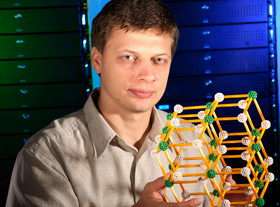Theory aims to describe fundamental properties of materials

Gold is shiny, diamonds are transparent, and iron is magnetic. Why is that? The answer lies with a material ’s electronic structure, which determines its electrical, optical, and magnetic properties.
Predicting a material’s properties by first calculating its electronic structure would cut down experimental time and might lead researchers to uncover new materials with unexpected benefits.
But commonly used simulations are inaccurate, especially for materials like silicon, whose strongly correlated electrons influence each other over a distance and make simple calculations difficult.
Now a team of researchers at Sandia National Laboratories may have a solution that offers huge potential. Sergey Faleev and his colleagues applied theoretical innovations and novel algorithms to make a hard-to-use theoretical approach from 1965 amenable to computation. The team ’s approach may open the door to discovering new phases of matter, creating new materials, or optimizing performance of compounds and devices such as alloys and solar cells.
Their paper, “Quasiparticle Self-Consistent GW Theory, ” appeared in the June 9, 2006, issue of �鶹��Ժical Review Letters. GW refers to Lars Hedin ’s 1965 theory that elegantly predicts electronic energy for ground and excited states of materials. “G ” stands for the Greens function — used to derive potential and kinetic energy — and “W ” is the screened Coulomb interaction, which represents electrostatic force acting on the electrons. “Quasiparticles ” are a concept used to describe particle-like behavior in a complex system of interacting particles. Self-consistent means the particle ’s motion and effective field, which determine each other, are iteratively solved, coming closer and closer to a solution until the result stops changing.
“Our code has no approximation except GW itself, ” said Faleev. “It ’s considered to be the most accurate of all GW implementations to date. ”
“It works well for everything in the periodic table, ” adds coauthor Mark van Schilfgaarde, a former Sandian now at Arizona State University. The paper reports results for diverse materials whose properties cannot be consistently predicted by any other theory. The 32 examples include alkali metals, semiconductors, wide band-gap insulators, transition metals, transition metal oxides, magnetic insulators, and rare earth compounds.
Describing force
“Everything in solids is held together by electrostatic forces, ” says van Schilfgaarde. “You can think of this as a huge dance with an astronomically large number of particles, 1023, that is essentially impossible to solve. The raw interactions among the particles are remarkably complex.
“Hedin replaced the raw interactions with ‘dressing ’ the particle with a screened interaction, ” van Schilfgaarde continues, “so the effective charge is much smaller. It becomes much more tractable but the equations become more complicated — you have an infinite number of an infinite number of terms. The hope is that the higher-order terms die out quickly. ”
The researchers ’ use of GW makes the expansion much more rapidly convergent.
“We ’re pretty confident we got the approach right, ” he says. He now would like another group to independently verify this way of framing the task.
Promise and challenges ahead
The researchers use a molecular dynamics code, VASP (Vienna Ab-initio Simulation Package) to model, for example, equations of state in high-energy-density matter. These equations of state depend on quantities like electrical conductivity. Calculating this requires detailed knowledge of the electronic structure — a perfect application for Faleev ’s work. The researchers hope to describe optical spectra, calculate total energy, and account for more than 10 atoms in a unit cell — at 100 times the current speed.
Accelerating the code would facilitate modeling in other research areas at Sandia, such as simulating titanium dioxide used in surface science, or aiding research into carbon nanotubes that might be used in electronic or optical devices.
“To calculate absorption or optical spectra is a huge problem, ” Faleev says with anticipation. “To make it faster is a huge problem. To make it more accurate is a huge problem. To incorporate VASP is a huge problem. ”
Van Schilfgaarde agrees. “It ’s quite an accomplishment to do it at all. It takes someone who is very strong in math, and a clever programmer. We spent easily five to six man-years between us to make it work.
“If we can get the approach right, we can have a theory that ’s universally accurate for anything we want — that ’s really pretty neat, just requiring knowledge of where the atoms are. ”
Van Schilfgaarde believes the theory ’s advantage would be to offer true insight into material behavior. “It ’s kind of like adding night-vision goggles to soldiers working in the dark, ” he says. “Probably in 10 years, ” adds Sergey, “everyone will use this. ”
Source: Sandia National Laboratories





















